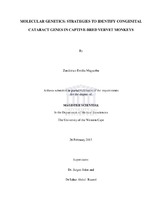| dc.description.abstract | The present study describes molecular aspects of inherited congenital cataract in captive-bred Vervet monkeys. Congenital cataracts are lens opacities that are present at birth or soon after birth and include hereditary cataracts or cataracts caused by infectious agents. The MRC Primate Unit is housing a colony of captive-bred Vervet monkeys in which 7.5% is suffering from congenital cataract. However, the parents of the affected individuals were asymptomatic. Six families within the colony have been identified to be affected by two types of morphologies (Y-sutural and total cataract). Based on the evidence provided above, it was speculated that the colony was affected with autosomal recessive cataract. The main aim of this study was to facilitate a strategy for managing breeding programs by minimizing cataract occurrences in captive-bred Vervet monkeys. Integrated combination of clinical, molecular and bioinformatic strategies were used to identify and assess reciprocal candidate susceptibility genes for cataracts. The genes that are known to be responsible for most human congenital cataract cases were prioritized. The genes include Heat shock transcription factor 4 (HSF4), Crystalline Alpha A (CRYAA), glucosaminyl (N-acetyl) transferase 2 (GCNT2) and Lens intrinsic membrane protein 2 (LIM2). Twenty two subjects were selected based on their morphology (5 carriers, 5 controls and 12 cataracts). 2ml of blood was collected for Deoxyribonucleic acid (DNA) extraction. Coding exons and flanking regions were screened by polymerase chain reaction (PCR) amplification and sequenced. The CLC DNA workbench was used for results analysis. The screening of four genes revealed 20 sequence variants which were not present in the control individuals. Sequencing of HSF4 revealed three mutations: R116R, L245>L and P421>L in exon 5, 10 and 14, respectively. The coding exons for CRYAA showed two sequence variants: S134W and K166N in exon 3. Twelve mutations were identified in exon one of all three GCNT2 transcripts (A, B and C). These mutations include: G212G, H256>H, M258>V, N275>N, V16>I, Y122>F, S15>S, S24>N, S38>S, I118>I, D194>D and Y373>Y which was found in exon three of all transcripts. There were no mutations in LIM2, however, three single nucleotide polymorphisms (SNPs) were identified in exon 2 (P66>P) and 3 (I118>T and A127>T). The above mutations were conserved when aligned with other species. The sequence variations vary among the families and those individuals with the same or different cataract phenotype. Based on these findings, it can be concluded that the four candidate genes harbour mutations that are responsible for both phenotypes. The effect of these mutations in Vervet monkeys is not yet understood, however, their impact will be further investigated. For future studies, it will be of absolute importance to screen the entire family to verify that indeed cataract formation in this colony is inherited in an autosomal recessive manner. | en_US |

